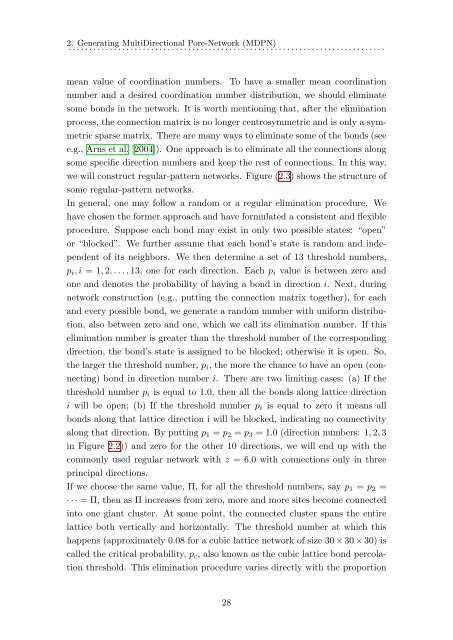download pdf version of PhD book - Universiteit Utrecht
download pdf version of PhD book - Universiteit Utrecht
download pdf version of PhD book - Universiteit Utrecht
Create successful ePaper yourself
Turn your PDF publications into a flip-book with our unique Google optimized e-Paper software.
2. Generating MultiDirectional Pore-Network (MDPN)<br />
. . . . . . . . . . . . . . . . . . . . . . . . . . . . . . . . . . . . . . . . . . . . . . . . . . . . . . . . . . . . . . . . . . . . . . . . . . . . .<br />
mean value <strong>of</strong> coordination numbers. To have a smaller mean coordination<br />
number and a desired coordination number distribution, we should eliminate<br />
some bonds in the network. It is worth mentioning that, after the elimination<br />
process, the connection matrix is no longer centrosymmetric and is only a symmetric<br />
sparse matrix. There are many ways to eliminate some <strong>of</strong> the bonds (see<br />
e.g., Arns et al. [2004]). One approach is to eliminate all the connections along<br />
some specific direction numbers and keep the rest <strong>of</strong> connections. In this way,<br />
we will construct regular-pattern networks. Figure (2.3) shows the structure <strong>of</strong><br />
some regular-pattern networks.<br />
In general, one may follow a random or a regular elimination procedure. We<br />
have chosen the former approach and have formulated a consistent and flexible<br />
procedure. Suppose each bond may exist in only two possible states: “open”<br />
or “blocked”. We further assume that each bond’s state is random and independent<br />
<strong>of</strong> its neighbors. We then determine a set <strong>of</strong> 13 threshold numbers,<br />
p i , i = 1, 2, . . . , 13, one for each direction. Each p i value is between zero and<br />
one and denotes the probability <strong>of</strong> having a bond in direction i. Next, during<br />
network construction (e.g., putting the connection matrix together), for each<br />
and every possible bond, we generate a random number with uniform distribution,<br />
also between zero and one, which we call its elimination number. If this<br />
elimination number is greater than the threshold number <strong>of</strong> the corresponding<br />
direction, the bond’s state is assigned to be blocked; otherwise it is open. So,<br />
the larger the threshold number, p i , the more the chance to have an open (connecting)<br />
bond in direction number i. There are two limiting cases: (a) If the<br />
threshold number p i is equal to 1.0, then all the bonds along lattice direction<br />
i will be open; (b) If the threshold number p i is equal to zero it means all<br />
bonds along that lattice direction i will be blocked, indicating no connectivity<br />
along that direction. By putting p 1 = p 2 = p 3 = 1.0 (direction numbers: 1, 2, 3<br />
in Figure 2.2)) and zero for the other 10 directions, we will end up with the<br />
commonly used regular network with z = 6.0 with connections only in three<br />
principal directions.<br />
If we choose the same value, Π, for all the threshold numbers, say p 1 = p 2 =<br />
· · · = Π, then as Π increases from zero, more and more sites become connected<br />
into one giant cluster. At some point, the connected cluster spans the entire<br />
lattice both vertically and horizontally. The threshold number at which this<br />
happens (approximately 0.08 for a cubic lattice network <strong>of</strong> size 30 × 30 × 30) is<br />
called the critical probability, p c , also known as the cubic lattice bond percolation<br />
threshold. This elimination procedure varies directly with the proportion<br />
28

















